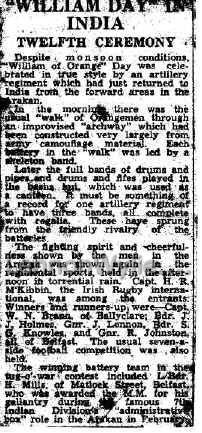 |
"William
Day" in India
Twelfth Ceremony
Despite monsoon conditions, "William of Orange Day" was
celebrated in true style by an artillery regiment which had just
returned to India from the forward areas in the Arakan. In the
morning, there was the usual "walk" of Orangemen through an
improvised "archway" which has been constructed very
largely from army camouflage material.
Each battery in the
"walk" was led by a skeleton band. Later the full
bands of drums and pipes and drums and fifes played in the basha hut,
which was used as a canteen. It must be something of a record for one
artillery regiment to have three bands, all complete with regalia.
These have sprung from the friendly rivalry of the batteries.
The fighting spirit and
cheerfulness shown by the men in the Arakan was shown again in the
regimental sports, held in the afternoon torrential rain. Capt. H. R.
McKibbin, the Irish Rugby international, was among the entrants.
Winners and runners-up were - Capt. W. N. Brann, of Ballyclare; Bdr.
J. J. Holmes, Gnr. J. Lennon, Bdr. S. G. Knowles, and Gnr. R.
Johnston, all of Belfast.
The usual seven-a-side football
competition was also held. The winning battery team in the tug-o'-war
contest included L/Bdr. H. Mills, of Matlock Street, Belfast, who was
awarded the M. M. for his gallantry during the famous 7th Indian
Division's "administrative box" role in the Arakan in
February. |
|
(on the
back of the above clipping)
...............dealing
with British ? provided by the British Council for American and Dominions
units in other parts of the United Kingdom.
Dies after Repatriation
__________________
Captain Lord Arundell, of Wardour Castle, Tisbury, Wilts, who was
recently repatriated from a German prisoner of war camp, died on Sunday
night at a military hospital in the North-West, where he was taken on his
arrival a week ago. He was 37. Lord Arundell was unmarried and the title
becomes extinct. His illness resulted from his wounds.
Sir Humphrey Rolleston, physician to King George V. and one of the
greatest authorities on health and disease of the past half century, died
at his home at Haslemere, Surrey, aged 82. He had been ill for a year.
A cyclone is devastating banana plantations and endangering crops worth
millions of pesos in Tabasco, Southern Mexico. Ships are unable to move,
and fruit is ripening aboard is being dumped into the sea.
Inmates of Pentridge, biggest prison in the State of Victoria, are making
toys for bombed-out British children. They have promised the first
installment of 120 toys for tomorrow.
Alexis Smith, blonde film actress who co-stars with Frederic March in
"The Adventures of Mark Twain" has been married to the actor
Craig Stevens at Glendale (California). The two met on a film set three
years ago. It was the first marriage for each.
L/Cpl. Arthur Thompson (34) stated to belong to the General Service Corps
and living at Bootle, Lancs., was charged at Bradford today with the
murder of Mrs. Jane Coulton, 69 years old widow licensee of the Nag's
Head Inn, Clayton...............
|
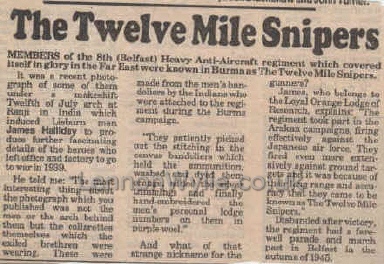 |
The
Twelve Mile Snipers
Members of the 8th (Belfast) Heavy Anti-Aircraft regiment, which covered
itself in glory in the Far East were known in Burma as The Twelve Mile
Snipers.
It was a recent photograph of some of
them under a makeshift Twelfth of July arch at Ranji in India which
induced Lisburn man James Halliday to produce further fascinating
details of the heroes who left office and factory to go to war in 1939. He
told me: "The most interesting thing about the photograph which you
published was not the men or the arch behind them but the collarettes
themselves which the exiled brethren were wearing.
These were made from the men's
bandoliers by the Indians who were attached to the regiment during the
Burma campaign. They patiently picked out the stitching in the canvas
bandoliers which held the ammunition, washed and dyed them orange, added
the silver trimmings and finally hand embroidered the men's personal lodge
numbers on them in purple wool."
And what of that strange nickname for
the gunners? James, who belongs to the Loyal Orange Lodge of Research,
explains; "The regiment took part in the Arakan campaigns, firing
effectively against the Japanese air force. They fired even more
extensively against ground targets and it was because of their long range
and accuracy that they came to be known as The Twelve Mile Snipers."
Disbanded after victory, the regiment had a farewell parade and march past
in Belfast in the autumn of 1945. |
 |
"Fare
Thee Well, Enniskillen"
in Burma Jungle with Belfast A.A. Men.
H.Q., South-East Asia Command - A full moon hung over the ridge of
jungle-covered hills in Burma. Suddenly through the cool evening air came
the sound of pipes playing "Fare Thee Well, Enniskillen." The
tune mingled with the mournful howl of jackals. The scene was the
gun-sites of a Belfast Heavy A.A. Regiment somewhere on the Arakan front
when I visited them recently, writes a military observer.
On
the other side of the hills, a few thousand yards away, were the Japanese,
although it was more than a day's hard climb through dense undergrowth
from the Japanese positions to the gun-sites. Next morning in the shadow
of the guns, an open-air church service was held. It was a simple service,
conducted by the Regiment's padre, Dermot Quinlan, of Lisnamandra,
Crossdoney, County Cavan, former curate assistant of St. James's, Antrim
Road, Belfast, which is now a bomb-scarred ruin.
To the accompaniment of a
portable organ, the men sang lustily the favourite hymn, "Oh God our
Help in Ages Past." These Irish gunners were quite contented. Their
location was on good, flat paddy fields edged by light scrub, with a
"chaung" nearby to bathe in. It was a pleasant change from the
jungle. The weather was good, with dry sunny days and cool crisp nights.
The men were tough and fit, and they
cleaned their guns clad only in khaki shorts. Perspiration gleamed on
their bodies which were tanned to a deep brown by the Burma sun. They were
happy, too, at the frequent opportunities they had of ranging their dual
purpose heavy guns on enemy ground targets - Japanese unit headquarters,
troop billets, ammunition dumps, even enemy infantry advancing across open
ground.
Recently the Belfast gunners caught
one hundred screaming fanatical Japs rushing across a paddy field. When
they had finished with them, forty dead or dying or wounded Japanese lay
sprawled among the paddy. One morning before breakfast they poured two
hundred shells on to an enemy ammunition dump. Large fires were started
and the gunners themselves could see the smoke from their sites ten miles
away. |
|
The 12th
July 1946
One banner, made from an ammunition cover, which was carried in front of
the 8th Belfast Memorial Pipe Band, who accompanied the 34th Ulster
Division Lodge, was designed by a Belfast man in Madras, India, last year
on the occasion of "Twelfth" celebrations there by members of
the 8th Belfast Heavy A. A. Regiment.
On the front of the banner is a
painting of a .37 gun being shelled and some of the wounded gunners
falling to the ground. This scene recalls an incident which occurred when
the 21st Battery was fighting in the Arakan. On the back is depicted a
memorial tablet with the words "Lest We Forget."
~~~~~~~~~~~~~~ 2
ARAKAN GUNNERS HOPE TO SCORE HIT ON TIN PAN ALLEY
Written and
composed by two gunners during fierce fighting in Arakan earlier this
year, the song "Let's Go Down Moonlight Row" may soon be a
popular favourite.
Gunner A. McQuitty, of Glasgow Street, York Road,
Belfast, who wrote the words, and Gunner R. McMillan, of Fleet Street,
Belfast, who composed the music, completed the song inside the 7th Indian
Division's "box", which the Division refused to evacuate for 18
days during which they were supplied by air.
The song was first sung on the gun-sites to
celebrate the Japs being "on the run" following this
stand. Encouraged by the approval of their friends, the song has
since been put over at battery shows and also at a special concert at the
Garrison Institute, Ranchi, where it was given a good reception.
Now the song is being published, and they hope it
will be a big success. |
During the Second World War many Orangemen served their country and
fought for the freedom of the world. There are a number of Orange lodges,
which trace their origins to ex-servicemen returning after the war, while
during the conflict itself a famous Twelfth of July parade took place
among the soldiers of the 8th AA Regiment (the Twelve Mile Snipers) who
were in Burma at that time. The men, who belonged to lodges back home,
ensured that the Twelfth was marked by making banners, erecting an arch
and holding a parade.
A letter from Corporal David Fallis,
North Irish Horse, who was from Enniskillen, reprinted in the Weekly
Telegraph in August 1943 details that a twelfth parade was held that year
while the regiment was “serving in a remote camp”, lambegs being
produced from large empty petrol containers, arches being erected, and
banners painted on large truck covers. A platform proceedings in the army
camp saw Bro. Sergeant Hubert Brown of Lisbellaw give a detailed account
of the events leading up to the Battle of the Boyne in 1690 and the
principles which the Order stood for, something which English soldiers
who had not known about the Institution found of interest.
~~~~~~
(over other
side of above clipping)
An
article about the Royal Victoria Hospital, a donation from the Belfast
Co-operative Society, (hard to read).....A select musical programme was
given by Miss Leila Webster, Miss Irene Howey, Miss Renee McCurry and
Messrs. R. R. Leitch, F. Taylor and Richard Crozier. Mr. Thomas McIlwaine
was accompanist.
________________________
Cat Painted Blue and White
Sequel in Portrush
At Portrush Petty Sessions on Wednesday a naval rating, Wm. E. Ascough
(19), Main Street, Bushmills, was fined £2. 10s for ill-treating a cat,
the property of Elizabeth McGoldrick, Bushmills. Police evidence was that
defendant was one of a number of youths - the others had already been
dealt with at Bushmills Court - who painted the cat blue and white and
tied a tin to its tail...........
{fantastic...... :) }
|
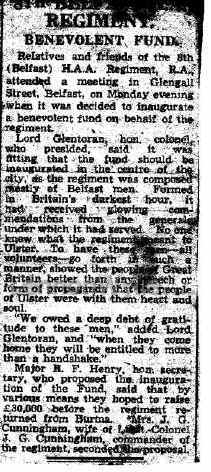 |
8th
Belfast R.A. Regiment
Benevolent Fund
Relatives and friends of the 8th (Belfast) H.A.A. Regiment, R.A., attended
a meeting in Glengall Street, Belfast, on Monday evening when it was
decided to inaugurate a benevolent fund on behalf of the regiment. Lord
Glentoran, hon. colonel, who presided, said it was fitting that the fund
should be inaugurated in the centre of the city, as the regiment was
composed mostly of Belfast men.
Formed in Britain's darkest hour, it
had received glowing commendations from the generals under which it had
served. No one knew what the regiment meant to Ulster. To have these men -
all volunteers - go forth in such a manner, showed the people of Great
Britain better than any speech or form of propaganda that the people of
Ulster were with them heart and soul.
"We owed a deep debt of
gratitude to these men," added Lord Glentoran and "when they
come home they will be entitled to more than a handshake." Major R.
F. Henry, hon. secretary, who proposed the inauguration of the Fund, said
that by various means they hoped to raise £30,000 before the regiment
returned from Burma. Mrs. J. G. Cunningham, wife of Lieut.-Colonel J. G.
Cunningham, commander of the regiment, seconded the proposal. |
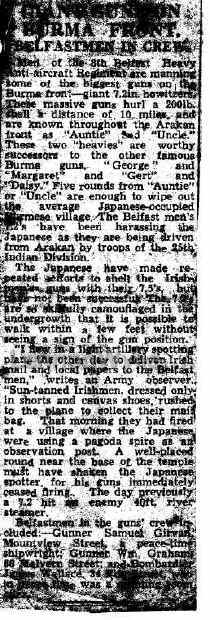 |
Giant
Guns on Burma Front
Belfast Men in Crew
Men of the 8th Belfast Heavy Anti-Aircraft Regiment are manning some of
the biggest guns on the Burma front - giant 7.2in. howitzers. (see here
for a hand made model) These massive guns hurl a 200lb. shell a distance
of 10 miles, and are known throughout the Arakan from as
"Auntie" and "Uncle."
These two "heavies" are worthy successors to the other famous
Burma guns, "George" and "Margaret" and
"Gert" and "Daisy." Five rounds from
"Auntie" or "Uncle" are enough to wipe out the average
Japanese-occupied Burmese village. The Belfast men's 7.2's have been
harassing the Japanese as they are being driven from Arakan by troops of
the 25th Indian Division. The Japanese have made repeated efforts to shell
the Irishmen's guns with their 7.5's, but have not been successful. The
7.2's are so skillfully camouflaged in the undergrowth that it is possible
to walk within a few feet without seeing a sign of the gun position.
"I flew in a light artillery
spotting plane the other day to deliver Irish mail, and local papers to
the Belfast men," writes an Army observer. "Sun-tanned Irishmen,
dressed only in shorts and canvas shoes, rushed to the plane to collect
their mail bag. That morning they had fired at a village where the
Japanese were using a pagoda spire as an observation post. A well-placed
round near the base of the temple must have shaken the Japanese spotter,
for his guns immediately ceased firing. The day previously a 7.2 hit an
enemy 40ft. river steamer.
Belfast men in the guns' crew
included:- Gunner Samuel Girvan, Mountview Street, a peace-time
shipwright; Gunner Wm. Graham, 68 Malvern Street; and Bombardier James
Wallace, 34 Fife Street, who is peace time was a spinning room oiler. |
|
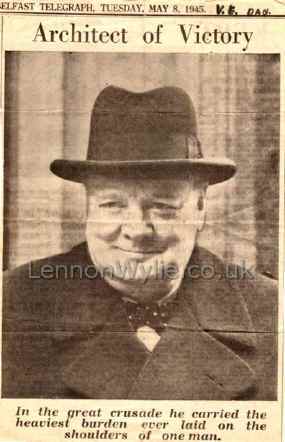
Belfast
Telegraph, Tuesday, May 8, 1945 V. E. Day
Winston Churchill
Architect of Victory
In the great crusade he carried the heaviest burden ever laid on the
shoulders of one man. |
(other
side of above clipping)
Death of Rev. J. A. Duke, ?ty Road in 1931, Lurgan in 1936. He retired
from the active work in 1940, but at the request of Oldpark Road Circuit
took charge of the new church at Joanmount, where he laboured acceptably
for four years. In June last he transferred to Springfield Road Church,
now linked with the Belfast Central Mission. Mr. Duke, who was esteemed
as one of the most genial and brotherly of men, served on many of the
leading committees and boards of the Church.
He had been ministerial secretary
and treasurer of the Supernumeracy Fund for several years, was a trustee
of the ?..tire Church, and a Governor of Methodist College. He was a
frequent contributor to the connexional organ, "The Irish Christian
Advocate" Mr. Duke is survived by his widow and one son. A memorial
service will be held in University Road Church on Wednesday afternoon,
and the interment will take place in Dublin on Thursday.
Sir, T. Somerset, M.P., Retiring.
(sorry paper is cut badly) Sir Thomas Somerset, M.P., for North Belfast
at Westminster since ? 1929, has decided to stand down at the general
election. On Monday evening the Executive Committee of the North Belfast
Parliamentary Division - embracing - Shankill, Oldpark, Duncairn and
Clifton - met under the chairmanship of Mr. S. H. McBride to consider the
question of nominating for the division at the general election. Sir,
Thomas, who had written to the secretary (Senator Joseph Cunningham)
attended the meeting and explained that on medical grounds he would not
allow his name....................
|
 |
Belfast
Telegraph, Tuesday, May 8, 1945
Victory Day in Belfast
Holiday Crowds prepare for tonight.
The scene in Belfast to-day, VE-Day, was in violent contrast with the
happenings of November 11, 1918. When the last World War reached the
Armistice stage. Shortly after 11 o'clock on that day the city went mad
and cheering crowds and riotous incidents were common. To-day the occasion
of the official ending of German tyranny the streets in the centre of the
city presented a quiet holiday appearance with crowds of people parading
about the flag-bedecked streets wearing favours of the Allied Nations, the
Union Jack predominating.
The big moment, of course, was when
the citizens assembled round the City Hall to hear Mr. Churchill's
declaration that the Nazi might had (have) been conquered. Last night's
preparations for bonfires around the city promise that to-night Belfast
will be ringed by friendly fires which the N.F.S. men can enjoy without
thought of their machines. The delay in announcing when VE-Day actually
would be led to considerable misunderstanding in regard to whether people
should go to work this morning but even this blunder led to colourful
episodes which heralded the festivities of the day.
Thousands of girls who had turned up
for work and found the factories closed marched through the streets
singing patriotic songs, and their linked ranks made a pleasant sight as
they swarmed along Royal Avenue and all over the city. Shortly after eight
o'clock this morning a big procession of young girls marched through
Templemore Avenue heading towards the Mount in East Belfast, while from
the Arches came another body of gay spirited youth singing all out. The
parties united and the gaiety of the scene was almost beyond description.
All the workers carried flags and
some were even dressed in Red White and Blue, but all were gay in the
realisation that freedom was triumphant. All public transport services had
been maintained at full strength, and holiday crowds went to Bellevue and
Hazelwood. Queues lengthened round the picture houses towards the hours of
opening, and there was every indication that after the stress of war the
people of the Ulster capital were out to enjoy themselves.
South-bound traffic in the city was
entirely suspended at 2.30 today by crowds who surrounded the City Hall to
await Mr. Churchill's speech. The crowd was a merry one, and in the centre
of the throng were parties dancing, solo musicians and bands of various
kinds.
|
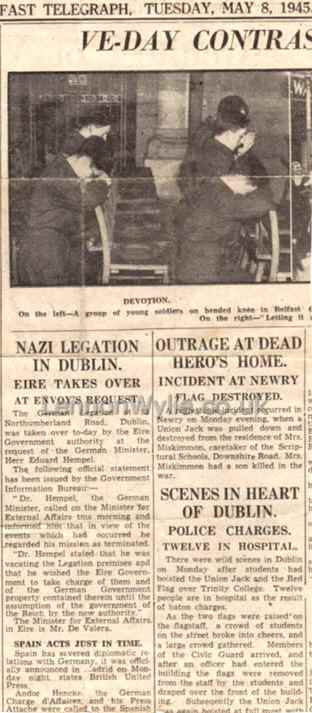 |
(also on
clipping)
Picture:- VE-Day (Contrast?) Devotion. On the left - A group
of young soldiers on bended knee in Belfast (Cathedral?)
On the right - Letting it (Go?)
Nazi Legation in Dublin.
Eire takes over at Envoy's Request.
The German Legation at 58
Northumberland Road, Dublin, was taken over to-day by the Eire Government
authority at the request of the German Minister, Herr Eduard Hempel. The
following official statement has been issued by the Government Information
Bureau:-
"Dr. Hempel, the German Minister, called on the Minister for External
Affairs this morning and informed him that in view of the events which had
occurred he regarded his mission as terminated. Dr. Hempel stated
that he was vacating the Legation premises and that he wished the Eire
Government to take charge of them and of the German Government property
contained therein until the assumption of the government of the Reich by
the new authority." The Minister for External Affairs in Eire is Mr.
De Valera.
Spain Acts Just in Time - Spain has severed diplomatic relations with
Germany, it was officially announced in Madrid on Monday night states,
British United Press. Andor Hencke, the German Charge d'Affaires, and his
Press Attaché were called to the Spanish..........(That's all)
Outrage at Dead Hero's Home - Incident at Newry - Flag Destroyed
A regrettable incident occurred in Newry on Monday evening, when a Union
Jack was pulled down and destroyed from the residence of Mrs. Miskimmon,
caretaker of the Scriptural Schools, Downshire Road. Mrs. Miskimmon had a
son killed in the war.
Scenes in Heart of Dublin - Police Charges - Twelve in Hospital
There were wild scenes in Dublin on Monday after students had hoisted the
Union Jack and the Red Flag over Trinity College. Twelve people are in
hospital as the result of baton charges. As the two flags were raised on
the flagstaff, a crowd of students on the street broke into cheers, and a
large crowd gathered. Members of the Civic Guard arrived, and after an
officer had entered the building the flags were removed from the staff by
the students and draped over the front of the building. Subsequently the
Union Jack was again hoisted at full mast with.............(sorry that's
all) |
 |
The Jungle Heroes are
honoured 56 years on
Daily Mail, Thursday,
August 16, 2001
by Chris Brooke
They
called it the railway of death, a 125 mile track through the Far Eastern
jungle whose story is as futile as it is tragic. Thousands of sick and
starving allied prisoners of war battled humid conditions, mosquitoes,
leeches and poisonous snakes to build the link across the island of
Sumatra in the final 15 months of the Second World War. Those who did not
drop dead from Malaria or malnutrition endured brutal treatment from
their Japanese captors.
Some 700 PoWs from Britain, Holland, Australia, New Zealand and the U.S.
died in the line's construction, along with 25,000 Sumatrans. It was
finished on the last day of the war then never used.
Yesterday, 56 years after the end of the war, old comrades unveiled a
monument to those who died at the National Memorial Arboretum in Alrewas,
near Lichfield, Staffordshire.
James Surr, 80, who worked on the line, recalled: 'I had dysentery 22
times, malaria 22 times and I was covered in tropical ulcers. We were all
very undernourished. Men who weighed 12 stone when they came into the
camp were reduced to about four or five when they left. The cruelty in
the camps was beyond anything I had ever witnessed before,' added Mr.
Surr, of Skipton, North Yorkshire.
'I'll never forgive the Japanese for what they have done to me and my
friends. This day for me is about honouring and paying tribute to
comrades and friends who fell at Sumatra and nothing else.'
The ceremony also saw the unveiling of a reconciliation stone. Lady
Pamela Hicks, daughter of Lord and Lady Mountbatten of Burma, recalled
her mother's encounters with freed PoWs in her tribute to them. She had,
she said, been amazed by 'the courage of these people who had gone
through so much'.
|
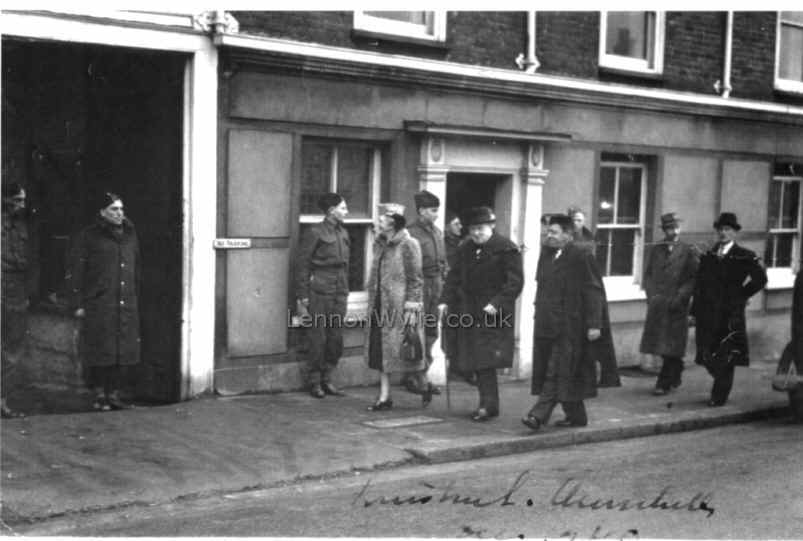
Winston S. Churchill
December 1940? - R.H.Q. Harrow-on-the-Hill
(the soldier
standing in the doorway, left of Churchill is James E. Mearns, he told
his relatives that on the day their instructions were to 'stand back and
not be obvious' - Thank you to Cindy Mearns for that information) |
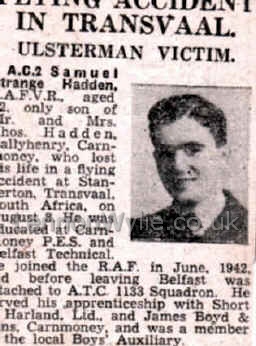 |
Flying
Accident in Transvaal. Ulsterman Victim.
A.C.2
Samuel Strange Hadden, R.A.F.V.R., aged 22, only son of Mr. and Mrs. Thos.
Hadden, Ballyhenry, Carnmoney, who lost his life in a flying accident at
Standerton, Transvaal, South Africa, on August 8. He was educated at
Carnmoney P.E.S. and Belfast Technical. He joined the R.A.F. in June,
1942, and before leaving Belfast was attached to A.T.C. 1133 Squadron. He
served his apprenticeship with Short & Harland Ltd., and James Boyd
& Sons, Carnmoney, and was a member of the local Boys' Auxiliary.
His
(Samuel Strange Hadden) demise was recorded in South Africa in 1945 and
the story is told in ‘Conversations With My Father’.
My father was acquainted with Samuel at the time.
Gary Duncan
........Thank
you to Gary Duncan for contacting me with this information
Mary
Aircraftman 2nd Class SAMUEL STRANGE HADDEN
1795663, Royal Air Force Volunteer Reserve
who died age 22
on 08th August 1945
Son of Thomas and Jeannie Ross Gourley Hadden, of
Belfast, Northern Ireland.
Remembered with honour
VEREENIGING OLD TOWN CEMETERY
|
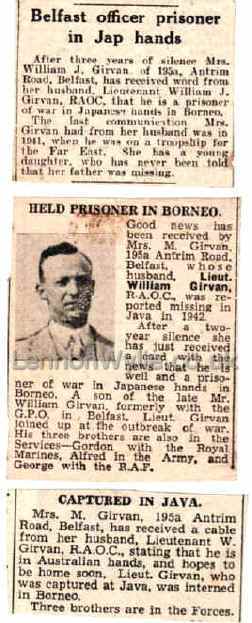 |
Belfast
officer prisoner in Jap hands -
After three years of silence Mrs. William J. Girvan of 195a Antrim Road,
Belfast, has received word from her husband, Lieutenant William J. Girvan,
R.A.O.C., that he is a prisoner of war in Japanese hands in Borneo. The
last communication Mrs. Girvan had from her husband was in 1941, when he
was on a troopship for the Far East. She has a young daughter, who has
never been told that her father was missing.
Held
Prisoner in Borneo -
Good news has been received by Mrs. M. Girvan, 195a Antrim Road, Belfast
whose husband, Lieut. William Girvan, R.A.O.C., was reported missing in
Java in 1942. After a two-year silence she has just received a card with
the news that he is well and a prisoner of war in Japanese hands in
Borneo. A son of the late Mr. William Girvan, formerly with the G.P.O. in
Belfast, Lieut. Girvan joined up at the outbreak of war. His three
brothers are also in the Services - Gordon with the Royal Marines, Alfred
in the Army, and George with the R.A.F.
Captured
in Java -
Mrs. M. Girvan, 195a Antrim Road, Belfast, has received a cable from her
husband, Lieutenant W. Girvan, R.A.O.C., stating that he is in Australian
hands, and hopes to be home soon. Lieut. Girvan, who was captured at Java,
was interned in Borneo. Three brothers are in the Forces. |
|
DUNKIRK
Three Ulster Veterans' Stories
Belfast Telegraph, Friday, June 2, 2000
Sixty years ago the German army forced British troops on to the beaches.
Military historian Richard Doherty talks to three Northern Ireland
soldiers who were there.
A miracle of deliverance .... that was how Winston Churchill described
it. For one Ulster veteran, it was "a disaster". The miracle
was the evacuation of 24,000 British, French and Polish troops from the
beaches of Dunkirk. The disaster was the fact that the British
Expeditionary Force (BEF) and the French army, once the envy of Europe,
had been defeated in less than a month.
When war broke out in September 1939, the BEF was despatched to support
the French army against German attack.
As in the First World War, the BEF
was deployed on the northern flank of the French army. In the following
months there was no movement on the ground and the men of the BEF
prepared defensive positions and trained during what the press dubbed the
"phoney war". Then, on May 10, 1940 the phoney ended. The
German army, supported by the Luftwaffe's planes, attacked France,
Belgium and the Netherlands, ignoring the neutrality of the latter two
countries. Immediately, the British Expeditionary Force was ordered to
move into Belgium to meet the Germans. Among the units of the BEF were
two recently formed artillery regiments from Northern Ireland - the 8th
(Belfast) Heavy Anti-Aircraft Regiment and the 3rd (Ulster) Searchlight
Regiment. Each played a full part in the short campaign that followed.
Such was the ferocity of the German
onslaught that the Allied armies were soon forced to retreat. With large
elements of the French army collapsing, it became clear that the BEF
would have to be evacuated from France, if its soldiers were not to
become prisoners. The force was ordered to fall back to the channel coast
at Dunkirk, from where it would be shipped to England. Casualties were
heavy as the troops made their way to the coast. There was confusion and
concern. Bert Sterling, a despatch rider with 10 Battery of 3rd (Ulster)
Searchlight Regiment, was 22 at the time.
"We kept being pushed back and back. The ordinary soldier really
didn't know much about what was happening and it was a worrying
time".
When 3rd (Ulster) Searchlight
Regiment reached Dunkirk, orders were issued for the destruction of all
equipment and vehicles. Searchlights were destroyed, lorries sabotaged
and "I had to take a sledge-hammer to my motorbike", recalls
Bert, who lives at Newtownabbey. His machine was a 500cc side-valve
Norton which, as a keen motorcyclist, he hated having to destroy. As the
regiment waited on the beach to be picked up, German aircraft
machine-gunned and bombed the lines of soldiers. "Their bombs made
many holes in the sand and we were grateful for that", Bert says.
"It gave us somewhere to hide whenever the planes came over. We were
very scared". Eventually the soldiers were rescued by a fleet of
little boats that took them out to the ships that waited to carry them to
England.
Most men left with only the uniform
they wore and a rifle. "Everything else had to be left behind,"
remembers Harry Porter, who was a sergeant in 21 Battery of 8th (Belfast)
HAA Regiment. Harry's battery was evacuated from Dunkirk amidst great
confusion, but the young sergeant's conduct on the retreat and during the
evacuation led to his being commissioned when the regiment returned to
Britain. Until its dissolution two years ago, Colonel Harry Porter was
the president of the Northern Ireland Branch of the Dunkirk Veterans'
Association. His view is that the campaign was "a great disaster,
even though it's being made out to be some sort of Victory". His
regiment lost all but two of its heavy anti-aircraft guns. The two that
were saved were brought out of Cherbourg by 22 Battery.
Not all of the BEF was able to reach
Dunkirk. Some units were cut off by the speedy German advance and had to
make for other ports, including Cherbourg and St. Malo. Cunningham Fowler
was a sergeant in 23 Battery of 8th (Belfast), which was unable to reach
Dunkirk and was forced to drive to St. Malo. "We first met the
Germans along the Seine between Paris and the coast," he says. His
battery had spent the night in a wood near the river and when morning
came they stood to their guns, knowing that there were the German troops
across the river. However, mist hung over the Seine valley and nothing
could be seen. "One of my detachment was a former field gunner and I
can still remember him saying to me: 'Sergeant, when that list lifts,
we're for it,' and he was right."
When the mist cleared the
Germans could be seen across the river and they soon opened fire on the
Belfast gunners. German soldiers were preparing to throw a pontoon bridge
across the river. Almost immediately two of the Cunningham Fowler's gun
detachment were killed. Before long the order to withdraw was received
and the Battery finally reached St. Malo from where it was evacuated to
Britain.
Last October, Major Fowler went back
to the scene of that engagement for the first time in almost 60 years. He
found the graves of his two comrades in a little French cemetery and met
a Frenchman who remembered the day the men died. That emotional
pilgrimage marks the true significance of Dunkirk and 1940 in the
memories of those who were there: the image of young men who had never
grown old, who were denied the opportunities of a normal life.
Their sacrifice is the true meaning
of Dunkirk; for without that there would have been no "miracle of
deliverance" and no rebuilding of a British army to continue the
struggle against Fascism.
for an
Appreciation of Col. Harry Porter OBE
http://www.lennonwylie.co.uk/obituary.htm
~~~~~~~~~~~~~
[What about the
conflicts against the Japs?]
The Battery from Belfast fought the Japs in Burma.
They had a
nickname, they called them the “12-mile snipers”. They could put a
shell into a railway tunnel at 12 miles. If they could see it, they could
hit it. The Colonel in charge of them was Jimmy …
Slim, the Australian General commanding the Burma campaign, said of him
“Jimmy never done a thing he was told, but he never got it wrong.”
The 12-mile snipers were very famous and
well-documented.
from http://www.bbc.co.uk/ww2peopleswar/stories/96/a8999996.shtml
[The
Nation's Biggest Thank you...for Victory in 1945] LINK
NO LONGER ONLINE
text from above link...
" Jim Lennon
Burma, 1945. Jim Lennon, one of the famous 12-Mile Snipers, is with his
Regiment, sweating it out and being eaten alive by mosquitoes deep in the
jungle. Japanese troops are waiting in their thousands. Jim knows it will
be a fight to the death. No one is expected to walk out of that jungle
alive. But Jim does. Yet his hardest battle lies ahead. Today, the onset
of osteoporosis has compromised Jim's mobility. He needed help and we were
proud and honoured to give it. The Legion provided him with a mobility
scooter. Now he finds it so much easier to care for his housebound wife
and get around.
We are here for all the other ex-Service men and women and their families,
too. From survivors of the World Wars through to those who served in more
recent troubles in Bosnia and The Gulf and on to the many thousands
serving around the world who may need us one day. People like Jim did
their duty. We will never forsake ours. Now or in the future. "
Battles
Beyond the Boyne
Burma
Star - Twelve Mile Snipers
Wikipedia |
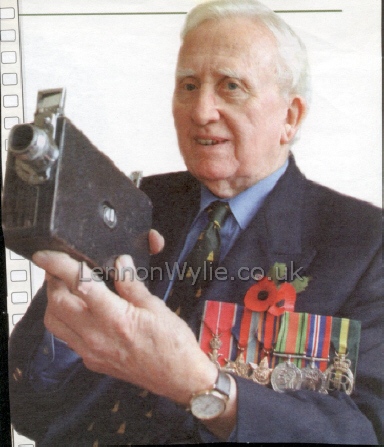
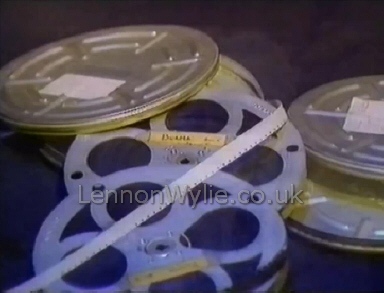
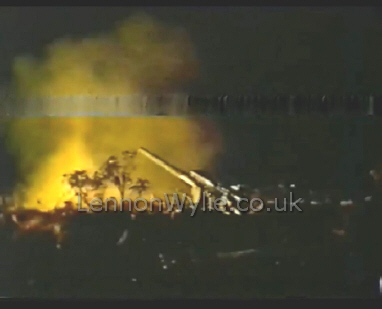
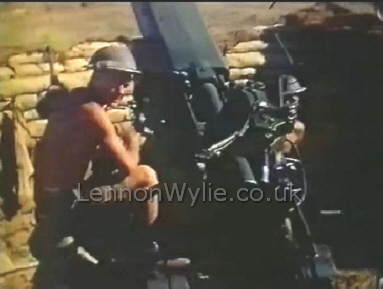
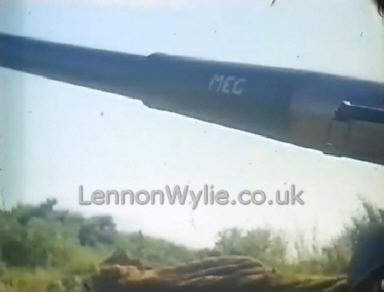
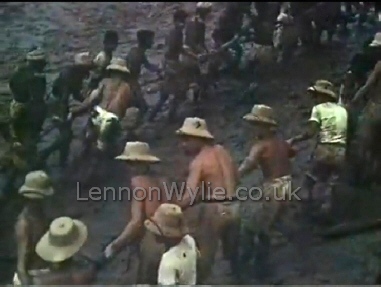
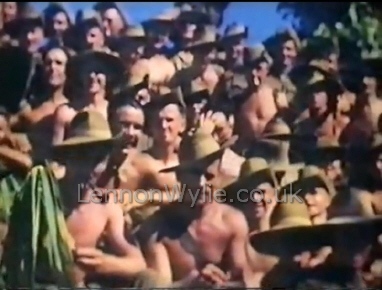
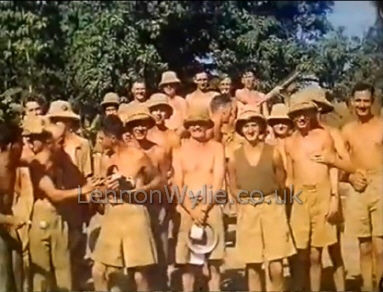
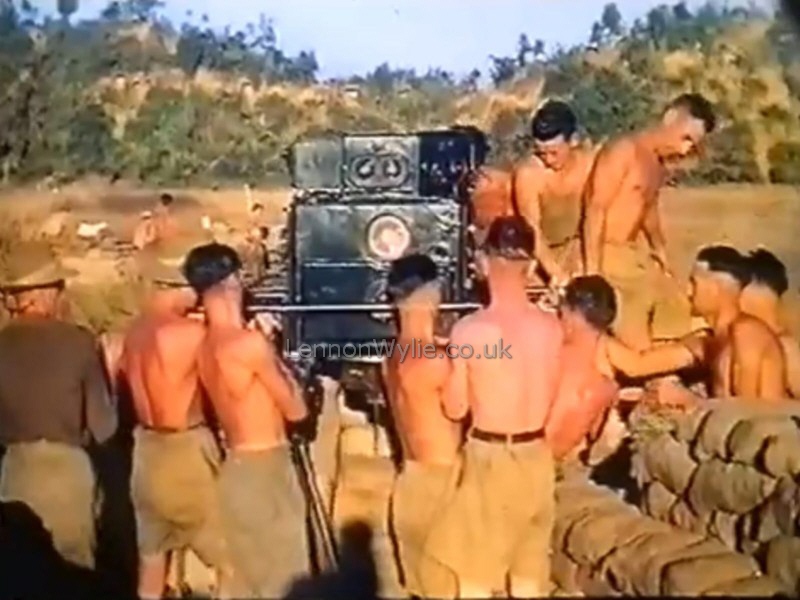
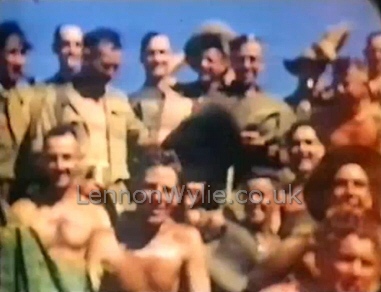 |
HARRY
PORTER talking about his film
"The Twelve Mile Snipers"
which you can watch here
or on YouTube
(I don't know which
newspaper this article came from)
Harry
Porter spent three years in Burma, fighting the Japanese and
battling his way through disease-infested jungle - while managing to
capture his experiences on cine film. Here he tells his dramatic
story to Andrew Wilson (possibly News-Letter)
As Japanese planes screeched through the Burmese sky, British troops
aimed their guns at the enemy and fired. A few moments later, one
of the men, Harry Porter, took hold of his cine camera and filmed the
fire enveloped aircraft falling through the sky and crashing into the
jungle.
This dramatic sequence is just one of thousands
of extraordinary scenes captured by Harry, one of the 8th Belfast
Regiment, Royal Artillery, during World War II. But what makes
these shimmering images even more unusual is the fact that they were
recorded using colour film. Although the most sensitive footage -
including the frames of the enemy plane being hit - was censored but the
Army authorities,** Harry was still left with reels of stunningly vibrant
material, some of which is featured in the television documentary series
Britain At War In Colour, narrated by John Thaw.
Harry's three years in Burma fighting the
Japanese is a story of astounding bravery and endurance, while his film
is a unique historical record of life during one of the most ferocious
conflicts of modern times. 'At the time, I didn't think what I was doing
was in any way significant,' says Colonel Harry Porter, O.B.E., now 80
and living with his wife Marjorie near Belfast. 'It was only years later
when my wife and I started to show the film in British Legion halls to
raise money for Army charities that people told me just how extraordinary
the footage was. Most of the film shot during the war was in black
and white, but colour really brings the scenes to life. It makes
the images seem more alive.'
Harry was 19 and working in his father's coal import business in Belfast
when war broke out. Harry and his friends enrolled in the 8th
Belfast Regiment, Royal Artillery, and he saw action at Dunkirk, and
then, in 1942, sailed with his regiment to India. Their mission was
to travel to Burma to try to stop the Japanese invading India. In
was while he was in Bombay that Harry wandered into a camera shop and
picked up a 16mm Eastman Kodak cine camera, newly arrived from
America. 'I can't remember how much it cost, but because the
exchange rate was so good, it didn't seem like too much money,' says
Harry, now president of the Burma Star Association of Northern
Ireland. 'The man in the shop told me that the film would
deteriorate in the humid conditions of Burma, so we came to an
arrangement where I would send the film to Calcutta for processing.
I had never heard of colour film before - it was a real novelty and I was
keen to experiment.
'After I bought the camera, I put it in the bottom of my kit bag and then
entered the war zone. While I was in Burma we were told that no
cameras were allowed - the Army did not want the enemy to use the
information to their advantage. I assumed that the war would be
over in the next couple of weeks and thought that nobody would find out
about the camera. Little did I know what trouble it was going to
get me into.'
Harry's footage shows his regiment both at work and at play, images which
offer an unprecedented view into the world at war. Captured on film are
the huge anti-aircraft guns which Harry and his colleagues would use to
fire on both planes and ground targets, The accuracy of the guns -
which the men would call after their sweethearts back at home - and the
skill with which they were used were borne out by the nickname given to
the regiment, The 12-Mile Snipers. 'The guns could fire a shell,
very accurately, up to a distance of 12 miles,' says Harry, 'while we
could also hit a plane thousands of feet high.'
Another nickname associated with the regiment which it bore with less
pride was 'The Forgotten Army', an expression articulated by Lord Louis
Mountbatten, whom Harry met in 1944. His regiment received a
message to send an officer to a specific map reference, where he's
receive orders. Harry was chosen for the mission and when he
arrived he was met by a man wearing a white suit, bedecked with medals.
'I walked towards the Jeep and learnt that the man covered in medals was
Louis Mountbatten, who told us he was our new commander-in-chief,' says
Harry. '"You call yourselves the Forgotten Army, don't
you?" said Mountbatten, "and you're right, because nobody has
ever heard of you." All of us were angry with him - indeed, he
called this the Day of the Deadly Hush because we were stunned into
silence - but then he got a map and explained the new strategy.
Instead of withdrawing every time we were surrounded, we were to stay put
and would be supplied with food, water and shells by air. It was
the plan that helped us defeat the Japanese.'
Throughout his three years in Burma, Harry survived on boiled rice and
bully beef, losing two stone in weight. He and his regiment endured
the constant threat of malaria, the heat of the jungle and the non-stop
rains of the monsoon. Footage captured by Harry shows the men
knee-deep in sticky, black mud pulling makeshift rafts through the
flooded paddy fields of Arakan. 'I'll never forget the leeches, which you
could see swimming towards you in waves through the mud,' says Harry. 'It
was a living nightmare, but none of us doubted our mission. We knew
we had to stop the Japanese, otherwise it would have been the end of the
world as we knew it.'
Harry's camera recorded every aspect of Army life, from football games
and water skiing on a lake in Kashmir to violent sequences such as the
blasting of enemy dug-outs and close-up images of dead Japanese
soldiers. Although the filming was against the Army's rules, his
superiors turned a blind eye, but when his reels of film were discovered
by the authorities in early 1945, after a search of the shop in Calcutta
where he sent his film for processing, Harry knew his was in
trouble. The Army wanted him to be court-martialled, but his case
was supported by his immediate superiors and the court martial was
dropped on condition that the most sensitive parts of his footage be
destroyed. 'Altogether I took about three hours' worth of film an it was
heartbreaking to know that around 40 per cent of that - really amazing,
powerful images - was going to be burnt,' says Harry, 'But I had no
choice. It was that or be court-martialled.'**
Later that year, Harry and the regiment travelled from Burma to Madras,
India, from where they sailed to Liverpool. Harry filmed the Liver
Building rising up through the September mist, and also his return home
to Belfast. 'The streets of Belfast were crowded and we paraded
past a line of dignitaries, including the Lord Mayor,' he says. 'It
was a real holiday atmosphere and we were so proud to have done what we
could for our country.'
In 1948, when Harry was back at work in his family's business, he married
Marjorie - now an M.B.E., but back in the war a special operator
monitoring enemy broadcasts - and the couple raised three children.
The camera, which Harry had once used to record the most brutal of
conflicts, now had a gentler task - filming his young family at home and
on holiday. 'It was lovely to film my children growing up,' says Harry,
who also has five grandchildren. 'I'll treasure those images for
ever.'
It is nearly 60 years since Harry first picked up his camera, but his
images of war, shockingly alive in colour, serve to remind us of the
horrors of a conflict nobody should ever forget. 'Watching the film today
brings the memory back in every detail.' he says, 'I just hope the
footage helps people understand what war was about and it should never be
allowed to happen again. It's a record of history in the making.'
|
| |
|
| |
|
| |
|
|